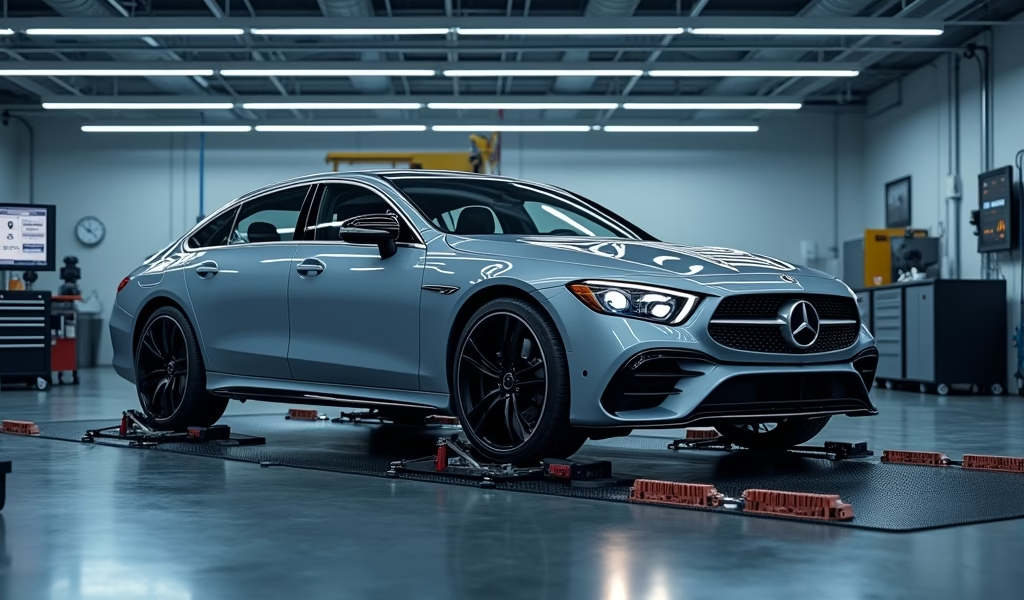Overview
This article explains how variable assist steering systems provide different levels of steering assistance based on driving conditions, and offers a detailed guide to calibrating these systems. It covers diagnostic signs of calibration issues, necessary tools, step-by-step procedures, common mistakes to avoid, and when professional help is needed.
Table of Contents
- Introduction
- What is Variable Assist Steering?
- Signs Your Steering Calibration Needs Attention
- Understanding Steering Assist Curves
- Pre-Calibration Checks
- Calibration Tools and Equipment
- Step-by-Step Calibration Process
- Common Calibration Mistakes to Avoid
- When to Seek Professional Help
- Maintaining Proper Steering Calibration
- Conclusion
- Frequently Asked Questions
Introduction
Ever noticed how your steering wheel feels light as a feather when parking but firms up nicely on the highway? That’s variable assist steering doing its job. As a mechanic who’s calibrated hundreds of these systems, I can tell you it’s not just about comfort—it’s a critical safety feature that ensures predictable handling in all driving conditions.
When your variable assist steering isn’t properly calibrated, you might feel like you’re fighting your car rather than driving it. I’ve seen drivers come in frustrated after their steering suddenly became unpredictable, only to leave smiling after a proper calibration.
In this guide, I’ll walk you through everything you need to know about variable assist steering calibration. Whether you’re a weekend warrior looking to tackle this yourself or just want to understand what your mechanic is doing, you’ll get the inside scoop on how this fascinating system works and how to keep it in tip-top shape.
What is Variable Assist Steering?

Variable assist steering is essentially an intelligent system that adjusts how much help you get when turning the steering wheel. Unlike old-school fixed systems that provide the same level of assistance regardless of speed, variable assist steering dynamically changes based on your driving conditions.
At low speeds, like when you’re navigating a crowded parking lot, the system increases assist, making the steering wheel light and easy to turn. Hit the highway at 70 mph, and the assist reduces, giving you that solid, connected-to-the-road feel that inspires confidence at higher speeds.
The system relies on several key components working together: a power steering pump (in hydraulic systems) or electric motor (in electric systems), a sophisticated control module, various sensors monitoring vehicle speed and steering input, and the actuators that deliver the assist. These components communicate constantly to provide the perfect amount of steering effort for any situation.
Modern vehicles often integrate the steering rack and pinion systems with variable assist technology, creating a seamless driving experience that adapts to changing conditions. This integration is why proper calibration becomes so important—it ensures all these complex parts work harmoniously.
Signs Your Steering Calibration Needs Attention
Your car has a way of telling you when something’s not right, and steering calibration issues are no exception. The most obvious sign is inconsistent steering feel—perhaps it’s too heavy when maneuvering at low speeds or unnervingly light when cruising on the highway.
I had a customer bring in her SUV complaining that the steering felt “jumpy” when changing lanes. After checking, I found her variable assist calibration was way off, making the assistance change abruptly instead of smoothly. After recalibration, she couldn’t believe it was the same vehicle.
Here are some common symptoms that indicate your steering calibration might need attention:
- Steering that feels too heavy or too light for the driving conditions
- Inconsistent effort needed to turn left versus right
- Steering wheel that doesn’t return to center properly
- Warning lights related to power steering or stability control
- Strange noises (whines, groans, or creaks) during steering maneuvers
- Steering that suddenly changes effort during a turn
Don’t ignore these signs. Improper steering calibration isn’t just annoying—it can compromise your ability to control your vehicle in emergency situations. According to NHTSA safety data, steering-related issues contribute to thousands of accidents annually.
Understanding Steering Assist Curves
Think of steering assist curves as the recipe that determines exactly how your steering feels. These aren’t just theoretical constructs—they’re carefully calibrated profiles that define the relationship between your vehicle’s speed and the amount of steering assistance provided.
Manufacturers spend countless hours determining the ideal assist curves for each vehicle model. A family sedan typically has lighter steering than a sports car, which prioritizes road feel and feedback. The engineers consider vehicle weight, suspension geometry, tire characteristics, and even the target market’s preferences.
Many modern vehicles offer different driving modes that adjust these assist curves on the fly. Switch to “Sport” mode, and you’ll immediately notice firmer steering with greater feedback. Select “Comfort,” and the assist increases for effortless cruising and parking.
When calibrating variable assist steering, technicians are essentially fine-tuning these curves to match the manufacturer’s specifications or, in some cases, adjusting them to accommodate modifications like larger tires or different suspension components. The steering box ratio calculations also play an important role in how these curves are implemented.
Pre-Calibration Checks
Before diving into calibration, I always tell my apprentices: “You can’t calibrate away mechanical problems.” There’s no point in adjusting software if the hardware isn’t right. Here’s my pre-calibration checklist that’s saved me countless hours of frustration:
- Check power steering fluid levels and condition (if hydraulic)
- Inspect power steering belt for proper tension and wear
- Verify tire pressure is even and at recommended levels
- Confirm wheel alignment is within specifications
- Check for loose steering components or worn bushings
- Inspect electrical connections for corrosion or damage
- Clear any existing error codes before calibration
I once had a customer who’d been to three different shops for a steering calibration, with no improvement. When I checked his vehicle, I found that his front tires were at drastically different pressures—38 PSI on one side and 28 PSI on the other! No amount of calibration would have fixed that imbalance.
Remember that steering feel is influenced by many factors beyond the assist system. Taking the time for these basic checks will save you headaches down the road and ensure your calibration efforts actually solve the problem.
Calibration Tools and Equipment

Let’s talk tools. Just like you wouldn’t use a hammer to tighten a bolt, you need the right equipment for steering calibration. This is where many DIYers hit a roadblock—proper calibration often requires specialized tools that go beyond basic OBD-II scanners.
At minimum, you’ll need a diagnostic scanner that can access your vehicle’s power steering control module. Generic code readers typically won’t cut it. Manufacturer-specific software is often required for precise calibration, especially in newer vehicles with advanced driver assistance systems.
Here’s what I use in my shop for variable assist steering calibration:
- Professional-grade diagnostic scanner (like Autel MaxiSys, Snap-on Zeus, or manufacturer-specific tools)
- Laptop with manufacturer service information subscription
- Battery maintainer to ensure stable voltage during calibration
- Torque wrench for any mechanical adjustments
- Digital pressure gauge for precise tire pressure verification
For the DIY crowd, there are some middle-ground options. Tools like FORScan work well for Ford vehicles, while OBDLink MX+ with the right software can handle some GM and Chrysler models. Just be aware of their limitations—these tools may not provide full access to all calibration parameters.
If you’re serious about DIY maintenance, investing in a quality diagnostic tool is worthwhile. As Motor Magazine explains, modern vehicles are increasingly computerized, making proper diagnostic equipment essential for even basic service tasks.
Step-by-Step Calibration Process
Now for the main event—the calibration itself. While the specific steps vary by vehicle make and model, here’s a general process I follow when calibrating variable assist steering systems:
First, safety comes first. Ensure your vehicle is on level ground with the parking brake engaged. For many calibration procedures, you’ll need to start with the engine off and the key in the appropriate position.
Connect your diagnostic tool and navigate to the power steering module or electric power steering system in the tool’s menu. Look for calibration, reset, or relearn functions—the terminology varies by manufacturer.
Some vehicles require you to center the steering wheel precisely before beginning calibration. Others need you to turn the wheel from lock to lock as part of the procedure. Follow your specific vehicle’s instructions exactly—improvisation rarely works here.
During the calibration, you’ll typically establish baseline parameters according to manufacturer specifications. This might involve setting the center position, minimum and maximum assist values, and the rate of change between assist levels.
After completing the calibration steps, you’ll need to drive the vehicle to “learn” the new settings. This often involves driving at various speeds in a safe environment to allow the system to adapt. Pay attention to how the steering feels during different maneuvers—parking, city driving, and highway cruising.
Don’t be afraid to make fine adjustments if something doesn’t feel right. The goal is steering that feels natural and predictable across all speed ranges, providing appropriate assistance without feeling disconnected from the road.
For vehicles equipped with rack and pinion steering systems, the calibration process may include measuring rack travel as part of ensuring the system operates correctly throughout its range of motion.
Common Calibration Mistakes to Avoid
In my years as a mechanic, I’ve seen plenty of calibration attempts go sideways. Here are the most common mistakes I see—and how you can avoid them:
Rushing through the process is mistake number one. Steering calibration isn’t a race, and skipping steps leads to poor results. I once had to fix a calibration done by someone who didn’t let the vehicle complete its learn procedure—they’d simply run through the menu options and called it done.
Another frequent error is attempting calibration when the real issue is mechanical. No amount of electronic adjustment will compensate for worn tie rod ends or a binding steering shaft. Always complete your pre-calibration checks thoroughly.
Many DIYers also make the mistake of inputting incorrect parameter settings. If your vehicle requires specific values to be entered, double-check them against reliable sources like factory service manuals. A single wrong value can make your steering feel worse than before.
Finally, I often see people fail to test their calibration thoroughly. A quick spin around the block isn’t enough—you need to experience the steering in various conditions to ensure it’s properly calibrated across all driving scenarios.
When to Seek Professional Help
While I’m all for DIY enthusiasm, there are times when calling in a professional makes sense. If your vehicle has an advanced steering system integrated with adaptive cruise control, lane-keeping assistance, or self-parking capabilities, the calibration becomes significantly more complex.
Persistent issues after seemingly successful calibration suggest deeper problems that might require specialized diagnosis. If you’ve carefully followed calibration procedures but still experience strange steering behavior, a professional shop with advanced diagnostic equipment can often pinpoint the issue quickly.
Consider warranty implications, too. If your vehicle is under warranty, DIY calibration might void coverage for steering-related components. The few dollars saved now could cost much more down the road if problems develop.
Don’t hesitate to ask questions when taking your vehicle to a shop. A reputable mechanic should be willing to explain what they’re doing and why. This isn’t just about getting your money’s worth—it’s about learning more about your vehicle and making informed decisions about its care.
Maintaining Proper Steering Calibration
Once your steering is properly calibrated, a bit of preventive maintenance will keep it that way. Most manufacturers recommend recalibration after major service work involving the steering or suspension components.
Any significant changes to your vehicle can affect steering calibration. This includes tire size changes, suspension modifications, or even substantial weight distribution changes (like adding heavy accessories). If you make these modifications, budget for recalibration as part of the project.
Extreme temperature changes, battery disconnection, or electrical system work can sometimes affect calibration settings. If you notice subtle changes in steering feel after such events, a quick recalibration might be in order.
Develop the habit of performing simple steering checks regularly. Does the wheel return to center properly? Is effort consistent when turning left versus right? Does the assist change appropriately with speed? These observations can help you catch calibration drift before it becomes problematic.
Conclusion
Variable assist steering calibration might seem like a complex topic, but it’s really about fine-tuning one of your vehicle’s most important safety systems. When properly calibrated, your steering should feel natural and predictable, adjusting seamlessly as you move from parking maneuvers to highway cruising.
Whether you decide to tackle calibration yourself or leave it to the professionals, understanding the process helps you become a more informed vehicle owner. The knowledge you’ve gained here will help you identify potential issues earlier and communicate more effectively with your mechanic if problems arise.
Remember that automotive technology continues to evolve, making some systems increasingly sophisticated. There’s no shame in recognizing when a job exceeds your tools or expertise—sometimes the smartest DIY decision is knowing when to call in a professional.
Keep these calibration principles in mind, listen to what your steering is telling you, and you’ll enjoy safer, more comfortable driving for years to come.
Frequently Asked Questions
How often should variable assist steering be calibrated?
Variable assist steering typically needs calibration after major steering or suspension work, not on a regular schedule. It may also require recalibration if you notice changes in steering feel or after replacing related components.
Can I calibrate my steering system without special tools?
For most modern vehicles, proper calibration requires vehicle-specific diagnostic equipment. Basic procedures like steering angle sensor resets might be possible with some consumer-grade scan tools, but full calibration typically requires professional equipment.
Will a steering calibration fix my power steering noise?
Calibration typically won’t resolve mechanical noises in your steering system. Whining, grinding, or knocking sounds usually indicate mechanical or hydraulic issues that should be addressed before calibration.
How much does professional steering calibration typically cost?
Professional steering calibration usually costs between $75-$200 depending on vehicle make and model. Complex systems with advanced driver assistance features may cost more due to additional calibration requirements.
Can changing tire size affect steering calibration?
Yes, significant tire size changes can affect steering feel and may require recalibration. The altered tire diameter changes the effective steering ratio and can make the assist feel inappropriate for different speeds.

